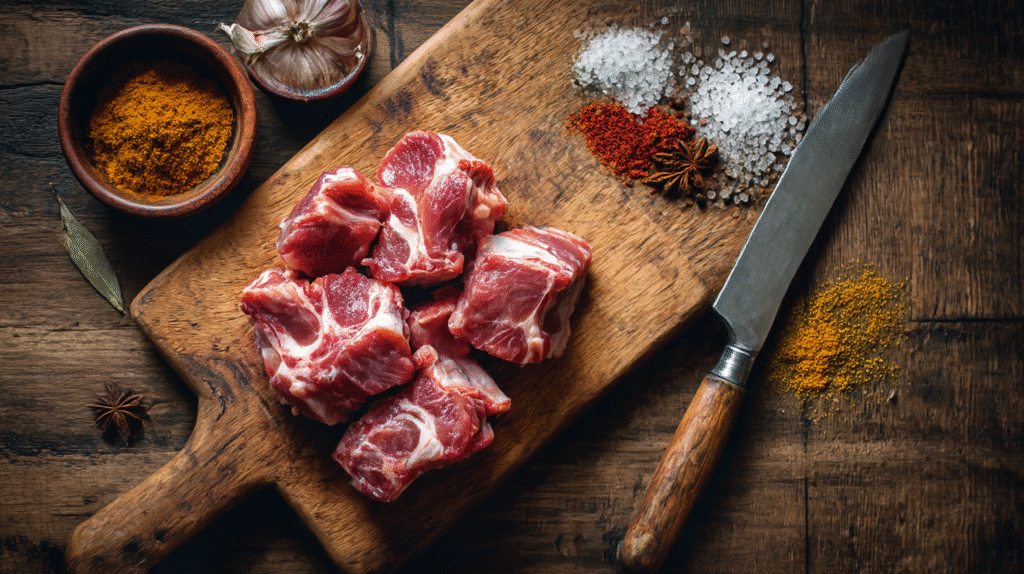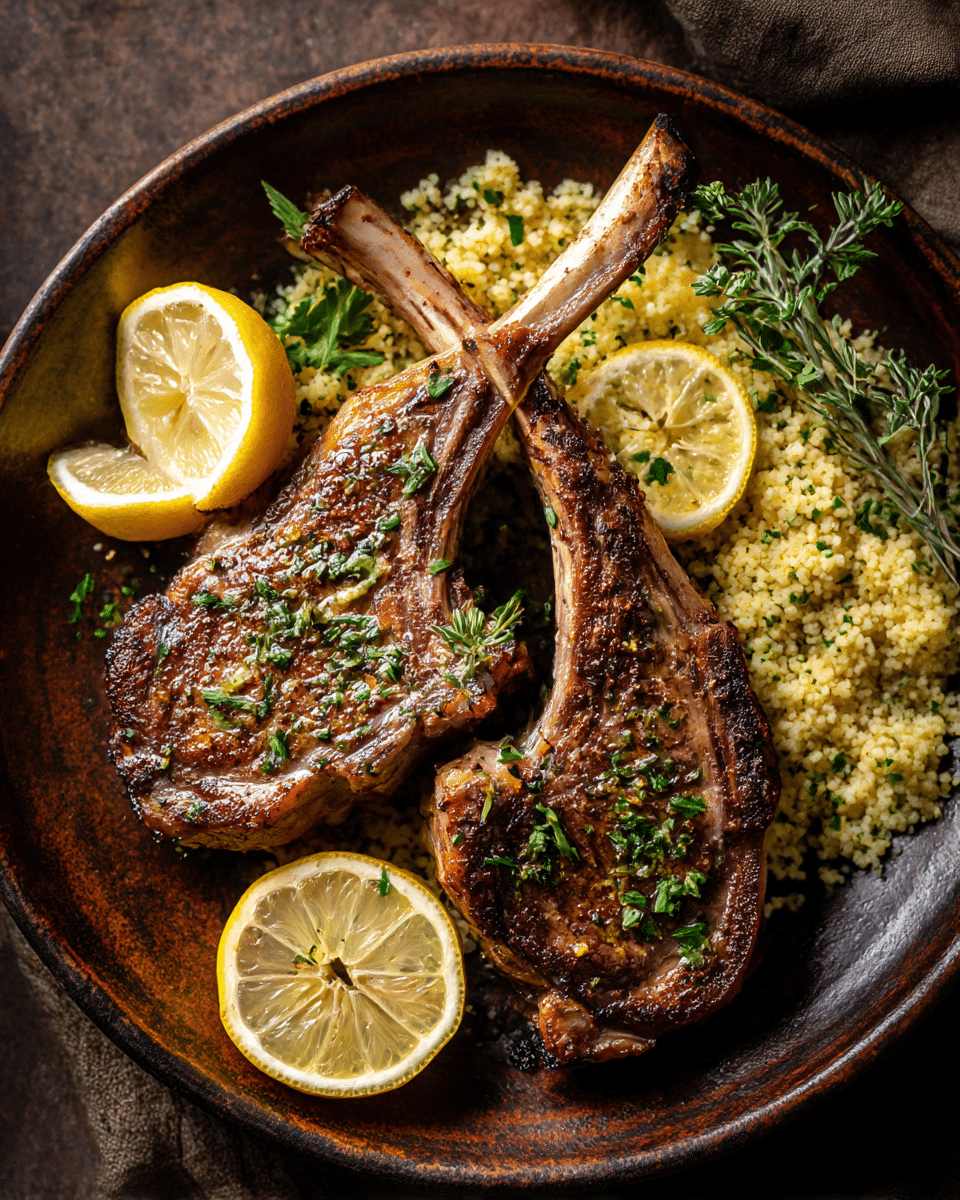Chopped Mutton vs Mutton Chops – What’s the Real Difference?
When I first started cooking for my food trailer in France, a customer once asked if I could prepare both chopped mutton and mutton chops for a family dinner. At the time, I smiled, but I remember thinking, “Aren’t they the same?” That moment sent me back to my childhood in Morocco, where I used to watch my mother carefully select the right cut for the right dish. There, the choice wasn’t random—it was meaningful.
So let’s clear up this common confusion: chopped mutton vs mutton chops might sound like two ways of saying the same thing, but they’re actually very different in cut, texture, and cooking method. Whether you’re prepping a quick dinner or a slow-cooked feast, knowing the difference can help you choose the perfect option for your recipe.
In this article, I’ll walk you through the key differences—what they are, how to cook them, and which one suits your next meal best. Let’s get started!
Table of Contents
What Is Chopped Mutton?
Defined by the Cut, Not the Bone
When we talk about chopped mutton, we’re usually referring to small, bite-sized pieces of meat that may or may not include bone. Unlike mutton chops—which are taken from a specific area like the rib or loin—chopped mutton can come from several different parts of the animal. It’s more about the preparation style than the anatomical origin.
Most often, the pieces are trimmed from larger cuts and then diced down for convenience. In many home kitchens, butchers prepare chopped mutton from the shoulder, leg, or neck, where the meat is slightly tougher but richer in flavor—perfect for slow-cooking. These pieces are ideal for allowing spices and marinades to sink deep into the meat.
Because it doesn’t rely on presentation and uniformity like chops do, chopped mutton is the go-to choice for rustic, saucy dishes where flavor is king.
Where and How to Use It
Chopped mutton is incredibly flexible in cooking. It’s commonly used in dishes that require long simmering—like traditional Indian curries, North African tagines, hearty stews, or Moroccan-style kefta (ground mutton). Because the small cuts cook evenly and absorb spices well, they’re a favorite for meals where every bite should be infused with deep flavor.
The texture can vary depending on the source cut—meat from the leg tends to be leaner, while neck or shoulder may be fattier and more tender when slow-cooked. That’s why chopped mutton is best in recipes that include plenty of liquid, such as broths or sauces.
If you prefer to prepare your cuts yourself to control size and fat content, check out our guide on how to chop mutton at home for practical tips and safety techniques.
They look deliberate, structured, and festive.
So how does chopped mutton vs mutton chops impact your choice when grilling? The answer often lies in how much time you have, how you want the meat to look on the plate, and the flavor intensity you're aiming for.
What Are Mutton Chops?
The Cut That Combines Bone, Fat, and Flavor
📺 Watch: Different Cuts of Lamb Chops Explained by Curtis Stone – a clear breakdown of rib, loin, and forequarter chops that helps visualize how mutton chops are cut and cooked.
While chopped mutton is all about small, mixed cuts, mutton chops are a more defined, premium selection. These come specifically from the rib, loin, or sometimes the shoulder. Each chop includes a bone—usually a section of rib—surrounded by tender meat and often a generous layer of fat. This fat melts during cooking, adding incredible depth and juiciness.
Unlike chopped mutton, which is often cut down from tougher parts of the animal, mutton chops are prized for their tenderness and rich marbling. They’re usually cut thick, with the bone acting as a flavor enhancer and heat conductor.
Because of their structure, chops are perfect for cooking methods that highlight their natural flavor—like grilling, broiling, or pan-searing.
When and Why to Use Mutton Chops
Mutton chops are ideal when you want a dish that feels refined and satisfying without needing hours in the kitchen. They cook quickly, usually in under 20 minutes, and shine with minimal seasoning. A simple marinade with garlic, herbs, or spices is often enough to bring out their bold taste.
They’re also an excellent choice for serving guests. Whether you’re planning a festive barbecue or an elegant weekend dinner, chops look impressive on the plate. If you’re aiming for that juicy, tender finish, make sure to check out our detailed recipe on how to make juicy mutton chops—a step-by-step guide for achieving perfect results.
For even more step-by-step guidance on preparing bone-in chops, The Kitchn’s lamb chop tutorial offers an easy oven-based method that works just as well for mutton.
In the chopped mutton vs mutton chops debate, chops clearly win when presentation and quick cooking are top priorities. They’re all about flavor, structure, and visual appeal.
“So how does chopped mutton vs mutton chops impact your choice when grilling?
Subscribe to Chopped-beef!
Get updates on the latest posts and more from Sofie Recipes straight to your inbox.
Basic Spiced Mutton Chops (Oven or Grill)
These basic spiced mutton chops are juicy, flavorful, and easy to prepare in the oven or on the grill. With just a few spices and a short cooking time, they’re perfect for weeknight dinners or special occasions. Inspired by Moroccan flavors and French simplicity, this recipe highlights the bold character of mutton chops without complicated steps. Serve with roasted vegetables, couscous, or a fresh salad for a complete meal.2Servings Number of serving 2Ingredients
Equipment
Method
Nutrition
Notes
📝 Notes
You can marinate the chops overnight for deeper flavor. Adjust spices based on taste. This method works equally well for lamb or goat chops.Did you make this recipe? Share a photo and tag us — Follow us at @chopped-beef_official for more
Share a photo and tag us — Follow us at @chopped-beef_official for moreCooking Methods Compared
Slow Heat vs High Flame
One of the biggest differences in the chopped mutton vs mutton chops comparison lies in how each cut responds to heat. Chopped mutton, with its smaller, uneven pieces and often tougher texture, is best cooked using slow, moist methods. Stewing, braising, or pressure cooking helps break down the connective tissue, making the meat tender and flavorful.
These methods are also great at helping spices seep into every bite. In Moroccan-style tagines or Indian curries, chopped mutton is simmered gently with garlic, onions, tomatoes, and warming spices until it practically melts into the sauce.
In contrast, mutton chops thrive under dry, direct heat. Whether grilled over charcoal or seared in a hot pan, chops develop a caramelized crust that locks in juices. The bone conducts heat evenly, while the fat renders slowly, creating a deliciously crisp edge.
Timing is crucial: while chopped mutton can simmer for an hour or more, mutton chops only need 10 to 15 minutes depending on thickness and desired doneness.
Texture, Cooking Time, and Results
If you’re after something saucy and rich that tastes even better the next day, chopped mutton is your go-to. It absorbs flavors during long cooking and turns incredibly tender. It’s the type of meat that rewards patience.
But when time is limited and you want bold flavor fast, mutton chops deliver. Their natural marbling and shape make them ideal for quick-cooking methods that keep the inside juicy and the outside golden.
You can also prep ahead: marinate chops for a few hours and cook them in minutes when ready. With chopped mutton, it’s best to cook it right after seasoning or let it sit overnight in a spice paste for deeper flavor.
“Knowing the difference between chopped mutton vs mutton chops helps avoid overcooking.”
Flavor and Presentation
What They Taste Like
The flavor profile is another key point when comparing chopped mutton vs mutton chops. Chopped mutton delivers deep, bold flavors thanks to its long cooking time and the spice-rich environments it’s usually prepared in. Since the pieces are small and often include fatty trimmings, they absorb marinades, broths, and spice blends exceptionally well. This results in a layered, intensely savory dish where each bite is soaked in flavor.
By contrast, mutton chops offer something more direct and meaty. Because they cook quickly, the seasoning tends to stay on the surface, but the high-heat cooking brings out natural umami from the meat and bone. You also get a combination of textures in each bite: tender interior, crispy edges, and a satisfying chew near the bone.
Mutton chops don’t need heavy sauces. A squeeze of lemon, a sprinkle of herbs, or a brush of garlic butter after grilling is often enough to let their flavor shine.
Visual Appeal and Occasions
Presentation-wise, chops have the advantage. Their curved bone, thick cut, and golden crust make them ideal for special occasions. You can serve them on a wooden board or plated with roasted vegetables or couscous for an elegant meal. They look deliberate, structured, and festive.
Chopped mutton, on the other hand, feels rustic and generous. It’s perfect for communal meals, slow-cooked tagines, or Sunday stews where flavor matters more than looks. It may not win a beauty contest, but it delivers comfort and satisfaction every time.
Choosing between them often depends on the moment: go with chopped mutton when feeding a group or making something rich and hearty. Reach for mutton chops when you want something fast, flavorful, and visually impressive.
“Whether you're serving guests or cooking for family, chopped mutton vs mutton chops offers two very different experiences.”
Subscribe to Chopped-beef!
Get updates on the latest posts and more from Sofie Recipes straight to your inbox.
Which One Should You Choose?
Match Your Cut to the Meal
When deciding between chopped mutton vs mutton chops, it really comes down to your recipe, cooking time, and the dining experience you want to create. If you’re preparing a slow-cooked curry, stew, or biryani, chopped mutton is the right choice. It’s forgiving, flavorful, and works beautifully in dishes that rely on long simmering.
But if you’re short on time and still want something satisfying, mutton chops are the better option. They cook quickly, pair well with simple sides, and shine in grilled or pan-seared preparations. You can even prepare them in advance by marinating and refrigerating them until you’re ready to cook.
For everyday meals, chopped mutton gives you flexibility. It’s perfect for batch cooking and storing leftovers. If you’re more focused on visual presentation or feeding a smaller group, mutton chops give you an elegant edge.
Home Prep or Butcher’s Choice?
Some home cooks prefer to chop mutton themselves to control the size and fat content. If you’re one of them—or want to try—it’s worth checking out our step-by-step guide on how to chop mutton at home. This way, you can decide how lean or fatty your cuts are and even tailor them to specific dishes.
On the other hand, if convenience matters more, mutton chops are usually ready to go from the butcher with minimal prep required. Just season and cook.
In short, both cuts have their place in the kitchen. Choosing the right one depends on the flavor, effort, and effect you’re aiming for. Keep both in your rotation, and you’ll always have the right option for the meal ahead.
FAQs About Chopped Mutton vs Mutton Chops
Can I use chopped mutton instead of mutton chops in a recipe?
It depends on the dish. Chopped mutton is great for curries, stews, and slow-cooked meals. If your recipe involves grilling or pan-searing, mutton chops are better suited. Swapping one for the other may change the texture and presentation, but the flavor can still be delicious with the right method.
Are mutton chops more expensive than chopped mutton?
Usually, yes. Mutton chops are a premium cut, often selected from the rib or loin, which are pricier parts of the animal. Chopped mutton, being a mix of cuts—sometimes from less tender sections—is typically more affordable and widely used in home cooking.
Which cut is healthier?
It depends on the fat content. Chopped mutton can be trimmed to reduce fat, especially if you chop it yourself. Mutton chops have visible fat and bone, which adds flavor but also increases calories. For leaner meals, go with trimmed chopped mutton or select lean chops with less marbling.
How do I know if I’ve bought the right cut?
Ask your butcher or check the label. Chopped mutton will be in small, irregular pieces, often boneless or with small bone fragments. Mutton chops are larger, uniform cuts with a central bone, and usually labeled specifically as “chops” or “cutlets.”
Final Thoughts: Choosing Between Chopped Mutton and Mutton Chops
So, in the great chopped mutton vs mutton chops debate, there’s no universal winner—just the right choice for the right dish. Chopped mutton brings bold flavor and versatility to slow-cooked meals, while mutton chops deliver juicy satisfaction in every seared bite.
If you love cooking with heart and flavor, keep both cuts in your kitchen. Use chopped mutton for comforting stews and everyday family dinners. Save the mutton chops for moments when you want something quick, impressive, and full of character.
The more you experiment, the easier it gets to match the cut to the moment. And in the end, that’s what real home cooking is all about.
Subscribe to Chopped-beef!
Get updates on the latest posts and more from Sofie Recipes straight to your inbox.
“Whatever your level of experience, understanding chopped mutton vs mutton chops adds confidence to every meal.”







